Heterogeneous Algorithm for Efficient-Path Detection and Congestion Avoidance for a Vehicular-Management System
Abstract
1. Introduction
- The heterogeneous algorithm is introduced, which combines the best aspects of two state-of-the-art algorithms (PT and ACO). ACO delivers an efficient and dependable approach using local and global search features. Furthermore, ACO incorporates real-time probabilistic and flexible properties. On the other hand, ACO has problems with convergence speed and accuracy when dealing with enormous amounts of data. To address the shortcomings of ACO, PT provides support for network scalability and vehicle mobility. The analytical model of PT is based on two separate parameters: packet-generation rate and pheromone sensitivity for single and multiple networks. Before delivering packets on each connection, the packet-generation rate minimizes congestion and pheromone sensitivity defines the link capacity. As a result, energy efficiency is improved.
- The novel congestion-avoidance model is intended to save fuel, minimize carbon emissions, and protect the environment. It is possible to achieve this by estimating the average speed of vehicle movement, which is affected by vehicle density. As a result, throughput is improved and energy usage is decreased.
- The automated-vehicle-detection module detects the presence and movement of vehicles in a given region by going through many phases (image preprocessing, contour detection, contour matching, and blob detection). As a consequence, the accuracy of automated detection is improved compared to other state-of-the-art methods.
2. Related Work
3. Proposed Heterogeneous Algorithm for Efficient-Path Detection
3.1. Overview of the Proposed System
3.2. Deployment of Pheromone-Termite Algorithm for Vehicle Management
3.3. Deployment of Ant-Colony-Optimization Algorithm for Vehicle Management
3.4. Heterogeneous ACO-PT Algorithm for Vehicle Management
| Algorithm 1: Deployment of ACO-PT for efficient-path detection |
|
4. Congestion-Avoidance and Vehicle-Detection Modules of ACO-PT for Vehicles
- ▪
- Congestion-avoidance module;
- ▪
- Automatic-vehicle-detection module.
4.1. Congestion-Avoidance Module
4.2. Automatic-Vehicle-Detection Module
- Image preprocessing;
- Contour detection;
- Matching contours;
- Blob detection.
| Algorithm 2: Automatic-vehicle-detection process |
|
4.2.1. Image Preprocessing
4.2.2. Contour Detection
4.2.3. Matching Contours
4.2.4. Blob Detection
5. Experimental Results and Discussion
- Throughput;
- End-to-end delay;
- Energy consumption.
5.1. Throughput
5.2. End-to-End Delay
5.3. Energy Consumption
6. Discussion of Results
7. Conclusions and Future Work
Author Contributions
Funding
Institutional Review Board Statement
Informed Consent Statement
Data Availability Statement
Acknowledgments
Conflicts of Interest
References
- Krell, E.; King, S.A.; Carrillo, L.R.G. Autonomous Surface Vehicle energy-efficient and reward-based path planning using Particle Swarm Optimization and Visibility Graphs. Appl. Ocean Res. 2022, 122, 103125. [Google Scholar] [CrossRef]
- Chen, G.; Yao, J.; Hu, H.; Gao, Z.; He, L.; Zheng, X. Design and experimental evaluation of an efficient MPC-based lateral motion controller considering path preview for autonomous vehicles. Control Eng. Pract. 2022, 123, 105164. [Google Scholar] [CrossRef]
- Liang, S.; Shao, H.; Wu, T.; Lam, W.H.K.; Zhu, E.C. An energy-efficient reliable path finding algorithm for stochastic road networks with electric vehicles. Transp. Res. Part C Emerg. Technol. 2019, 102, 450–473. [Google Scholar]
- You, G. Sustainable vehicle routing problem on real-time roads: The restrictive inheritance-based heuristic algorithm. Sustain. Cities Soc. 2022, 79, 103682. [Google Scholar] [CrossRef]
- Yesodha, R.; Amudha, T. A bio-inspired approach: Firefly algorithm for Multi-Depot Vehicle Routing Problem with Time Windows. Comput. Commun. 2022, 190, 48–56. [Google Scholar] [CrossRef]
- Alp, G.; Alkaya, A.F. An investigation of nature inspired algorithms on a particular vehicle routing problem in the presence of shift assignment. Comput. Oper. Res. 2022, 141, 105685. [Google Scholar] [CrossRef]
- Zhou, Z.; Roncoli, C. A scalable vehicle assignment and routing strategy for real-time on-demand ridesharing considering endogenous congestion. Transp. Res. Part C Emerg. Technol. 2022, 139, 103658. [Google Scholar] [CrossRef]
- Pasandi, L.; Hooshmand, M.; Rahbar, M. Modified A* Algorithm integrated with ant colony optimization for multi-objective route-finding; case study: Yazd. Appl. Soft Comput. 2021, 113, 107877. [Google Scholar] [CrossRef]
- Xiang, X.; Qiu, J.; Xiao, J.; Zhang, X. Demand coverage diversity-based ant colony optimization for dynamic vehicle routing problems. Eng. Appl. Artif. Intell. 2020, 91, 103582. [Google Scholar] [CrossRef]
- Reddy, D.L.; Puttamadappa, C.; Suresh, H.N. Merged glowworm swarm with ant colony optimization for energy efficient clustering and routing in Wireless Sensor Network. Pervasive Mob. Comput. 2021, 71, 101338. [Google Scholar] [CrossRef]
- Amutha, J.; Sharma, S.; Sharma, S.K. An energy efficient cluster-based hybrid optimization algorithm with static sink and mobile sink node for Wireless Sensor Networks. Expert Syst. Appl. 2022, 203, 117334. [Google Scholar] [CrossRef]
- Skackauskas, J.; Kalganova, T.; Dear, I.; Janakiram, M. Dynamic impact for ant colony optimization algorithm. Swarm Evol. Comput. 2022, 69, 100993. [Google Scholar] [CrossRef]
- Noussaiba, M.; Rahal, R. An Enhanced routing algorithm using ant colony optimization and VANET infrastructure. In Proceedings of the ICTLE’18, 6th International Conference on Traffic and Logistic Engineering, Bangkok, Thailand, 3–5 August 2018. [Google Scholar]
- Boyineni, S.; Kavitha, K.; Sreenivasulu, M. Mobile sink-based data collection in event-driven wireless sensor networks using a modified ant colony optimization. Phys. Commun. 2022, 52, 101600. [Google Scholar] [CrossRef]
- Rastogi, R.; Srivastava, S.; Manshahia, M.S.; Kumar, N. A hybrid optimization approach using PSO and ant colony in wireless sensor network. Mater. Today Proc. 2021. [Google Scholar] [CrossRef]
- Tuani, A.F.; Keedwell, E.; Collett, M. Heterogenous adaptive ant colony optimization with 3-opt local search for the travelling salesman problem. Appl. Soft Comput. 2020, 97, 106720. [Google Scholar] [CrossRef]
- Kyriakakis, N.A.; Marinaki, M.; Marinakis, Y. A hybrid ant colony optimization-variable neighborhood descent approach for the cumulative capacitated vehicle routing problem. Comput. Oper. Res. 2021, 134, 105397. [Google Scholar] [CrossRef]
- Abdul, R.; Abdulgader, M.; Joshi, C.; Amsaad, F.; Chauhan, M. P-LEACH: Energy efficient routing protocol for wireless sensor networks. In Proceedings of the 2016 IEEE Long Island Systems, Applications and Technology Conference (LISAT), Farmingdale, NY, USA, 29 April 2016; IEEE: Piscataway, NJ, USA, 2016; pp. 1–5. [Google Scholar]
- Zhang, Q.; Wang, Z.; Huang, M.; Yu, Y.; Fang, S.-C. Heterogeneous multi-depot collaborative vehicle routing problem. Transp. Res. Part B Methodol. 2022, 160, 1–20. [Google Scholar] [CrossRef]
- Khabiri, M.; Ghaffari, A. Energy-Aware Clustering-Based Routing in Wireless Sensor Networks Using Cuckoo Optimization Algorithm. Wirel. Pers. Commun. 2018, 98, 2473–2495. [Google Scholar] [CrossRef]
- Fatemidokht, H.; Rafsanjani, M.K. F-Ant: An effective routing protocol for ant colony optimization based on fuzzy logic in vehicular ad hoc networks. Neural Comput. Appl. 2018, 29, 1127–1137. [Google Scholar] [CrossRef]
- Anandh, S.J.; Baburaj, E. Energy efficient routing technique for wireless sensor networks using ant-colony optimization. Wirel. Pers. Commun. 2020, 114, 3419–3433. [Google Scholar] [CrossRef]
- Oh, E.; Lee, H. Effective Route Generation Framework using Quantum Mechanism-based Multi-directional and Parallel Ant Colony Optimization. Comput. Ind. Eng. 2022, 169, 108308. [Google Scholar] [CrossRef]
- Manoj, S.; Singh, R.; Sachdeva, A.; Singh, C. Improvisation of optimization technique and AODV routing protocol in VANET. Mater. Today Proc. 2022, 49, 3457–3461. [Google Scholar]
- Zambrano-Martinez, J.L.; Calafate, C.T.; Soler, D.; Lemus-Zúñiga, L.-G.; Cano, J.-C.; Manzoni, P.; Gayraud, T. A centralized route-management solution for autonomous vehicles in urban areas. Electronics 2019, 8, 722. [Google Scholar] [CrossRef]
- Wei, H.; Zhang, S.; He, X. Shortest path algorithm in dynamic restricted area based on unidirectional road network model. Sensors 2020, 21, 203. [Google Scholar] [CrossRef]
- Abdul, R.; Elleithy, K. Pheromone Termite (PT) Model to Provide Robust Routing over Wireless Sensor Networs. In Proceedings of the IEEE International Conference of the American Society for Engineering Education, Istanbul, Turkey, 3–5 April 2014. [Google Scholar]
- Yaqoob, S.; Ullah, A.; Akbar, M.; Imran, M.; Shoaib, M. Congestion avoidance through fog computing in internet of vehicles. J. Ambient. Intell. Humaniz. Comput. 2019, 10, 3863–3877. [Google Scholar] [CrossRef]
- Liu, C.; Kou, G.; Zhou, X.; Peng, Y.; Sheng, H.; Alsaadi, F.E. Time-dependent vehicle routing problem with time windows of city logistics with a congestion avoidance approach. Knowl. Based Syst. 2020, 188, 104813. [Google Scholar] [CrossRef]
- Li, Y.; Wang, J.; Huang, J.; Li, Y. Research on Deep Learning Automatic Vehicle Recognition Algorithm Based on RES-YOLO Model. Sensors 2022, 22, 3783. [Google Scholar] [CrossRef] [PubMed]
- Noussaiba, M.; Rahal, R. State of the art: VANETs Applications and their RFID-based systems. In Proceedings of the Codit’17: International Conference on Control, Decision and Information Technologies, Barcelona, Spain, 5–7 April 2017. [Google Scholar]
- Abdul, R.; Elleithy, K.M. Energy-efficient boarder node medium access control protocol for wireless sensor networks. Sensors 2014, 14, 5074–5117. [Google Scholar]
- Available online: https://github.com/agacia/ovnis (accessed on 29 August 2022).
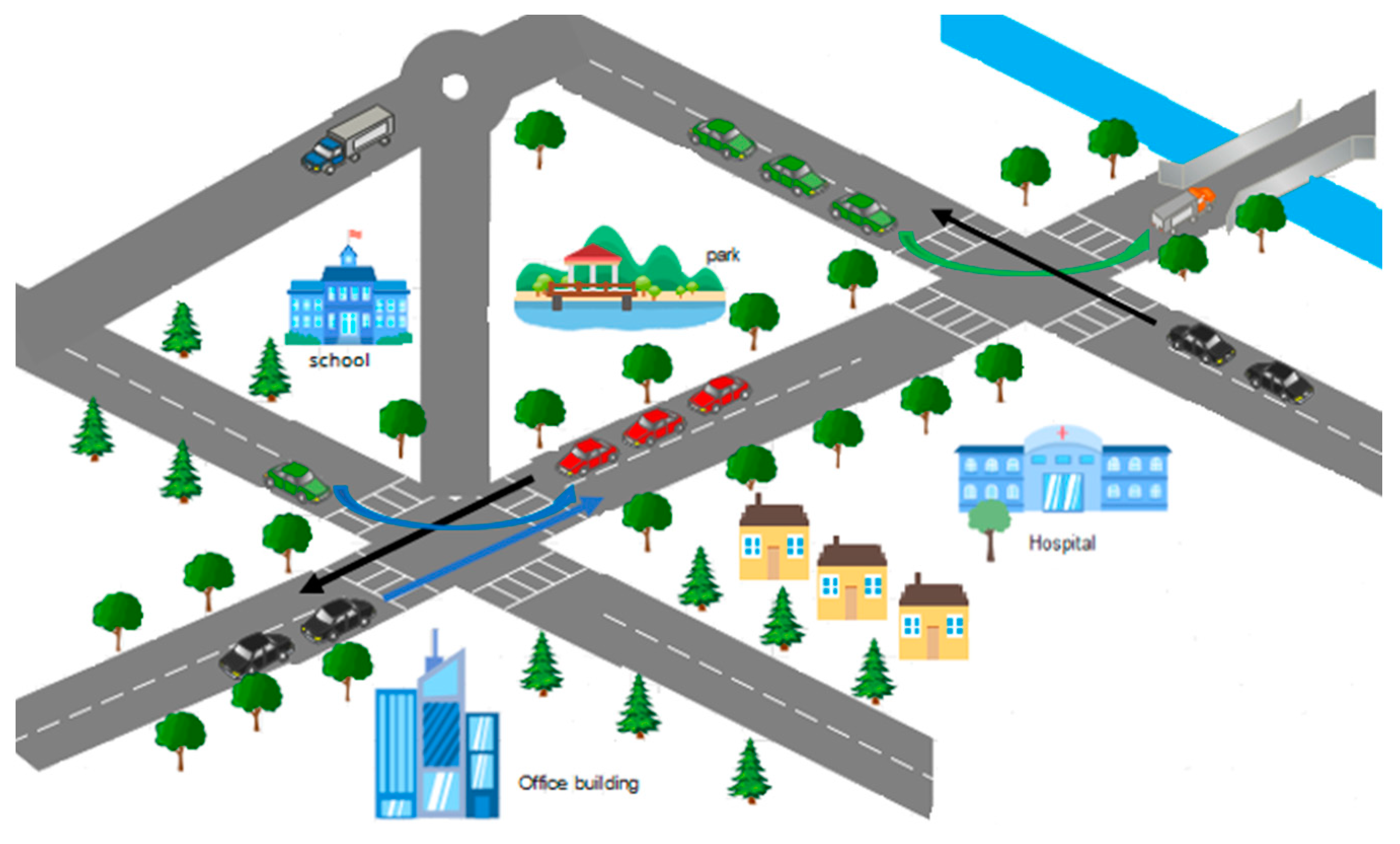
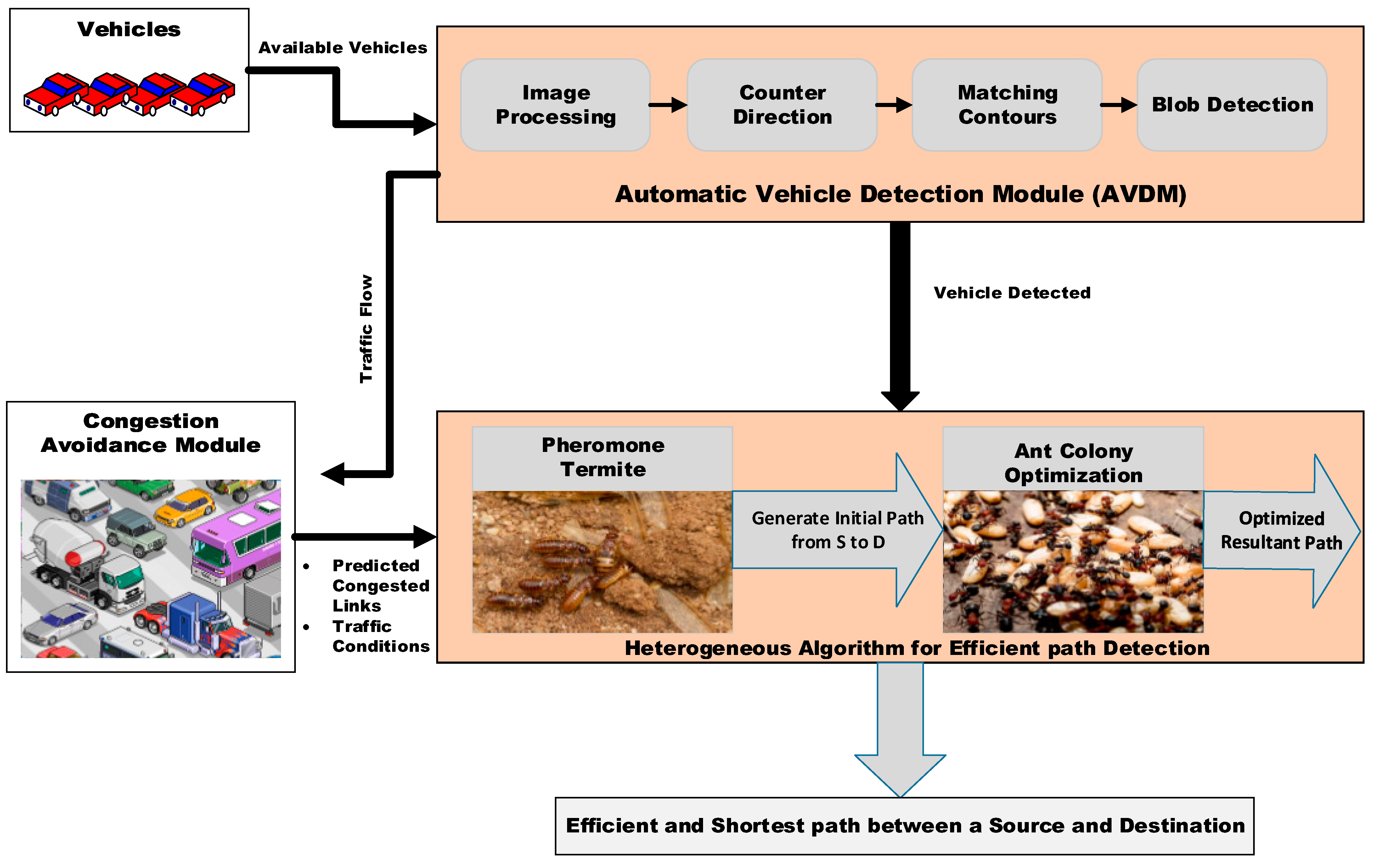
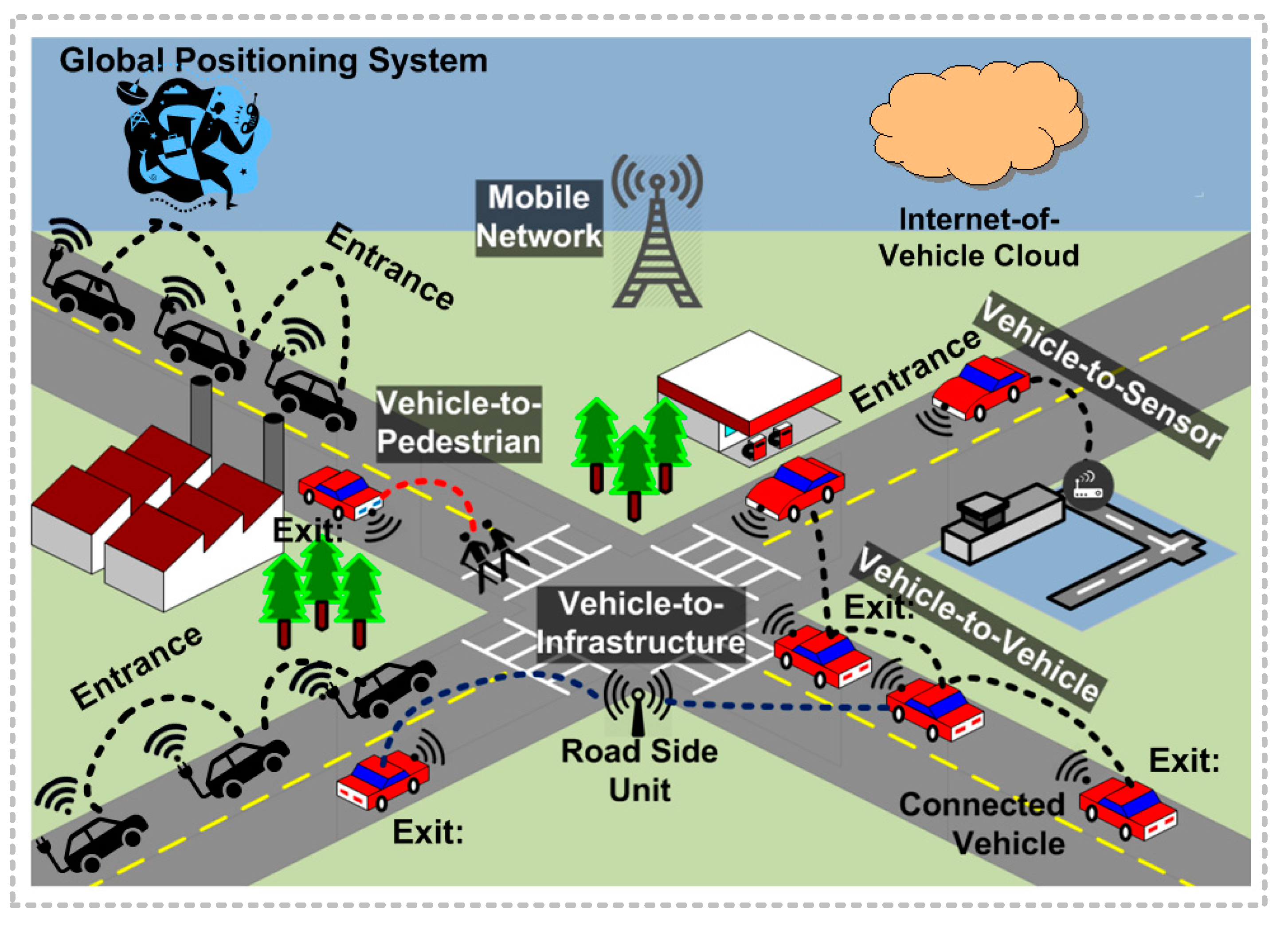

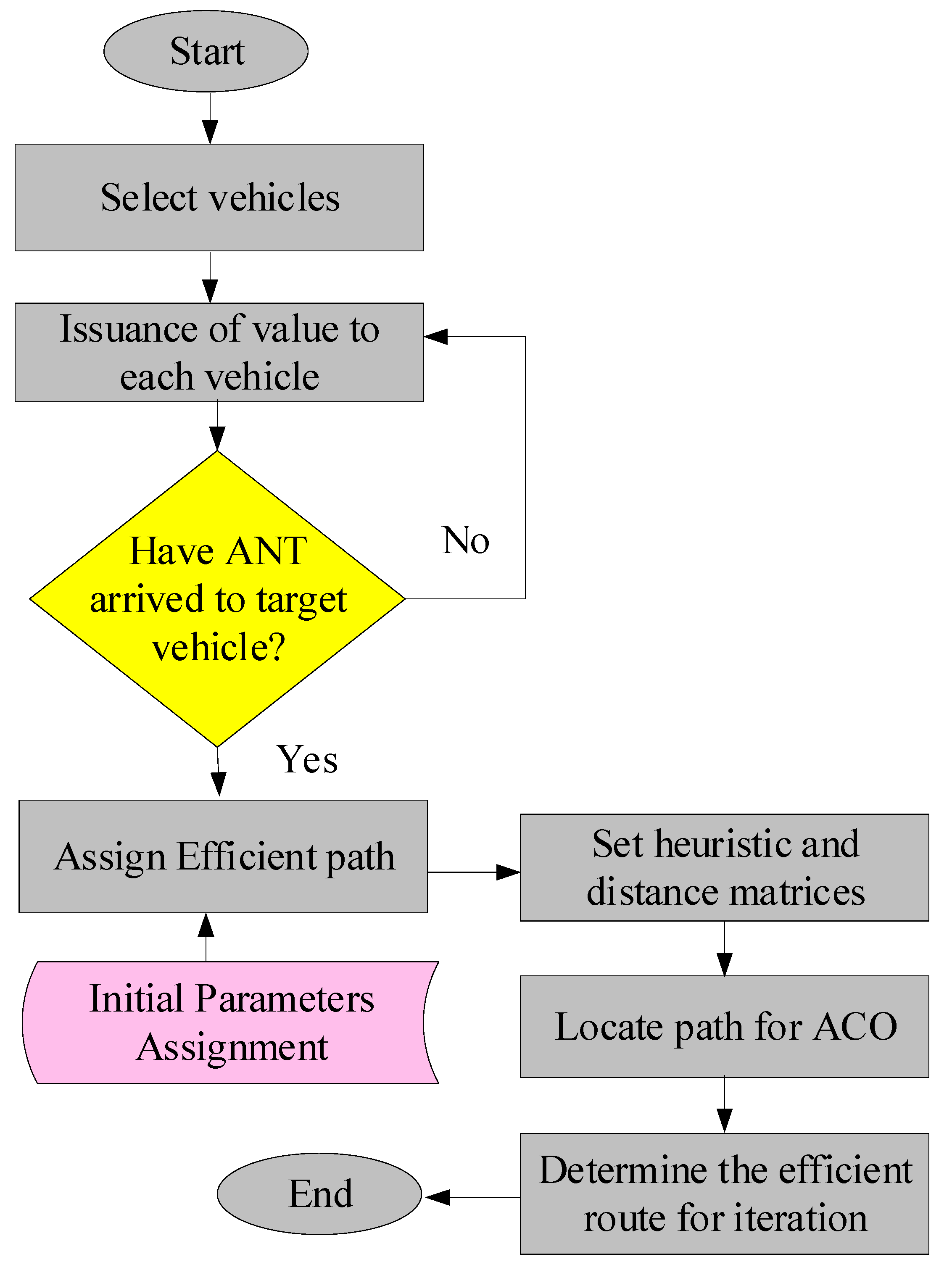
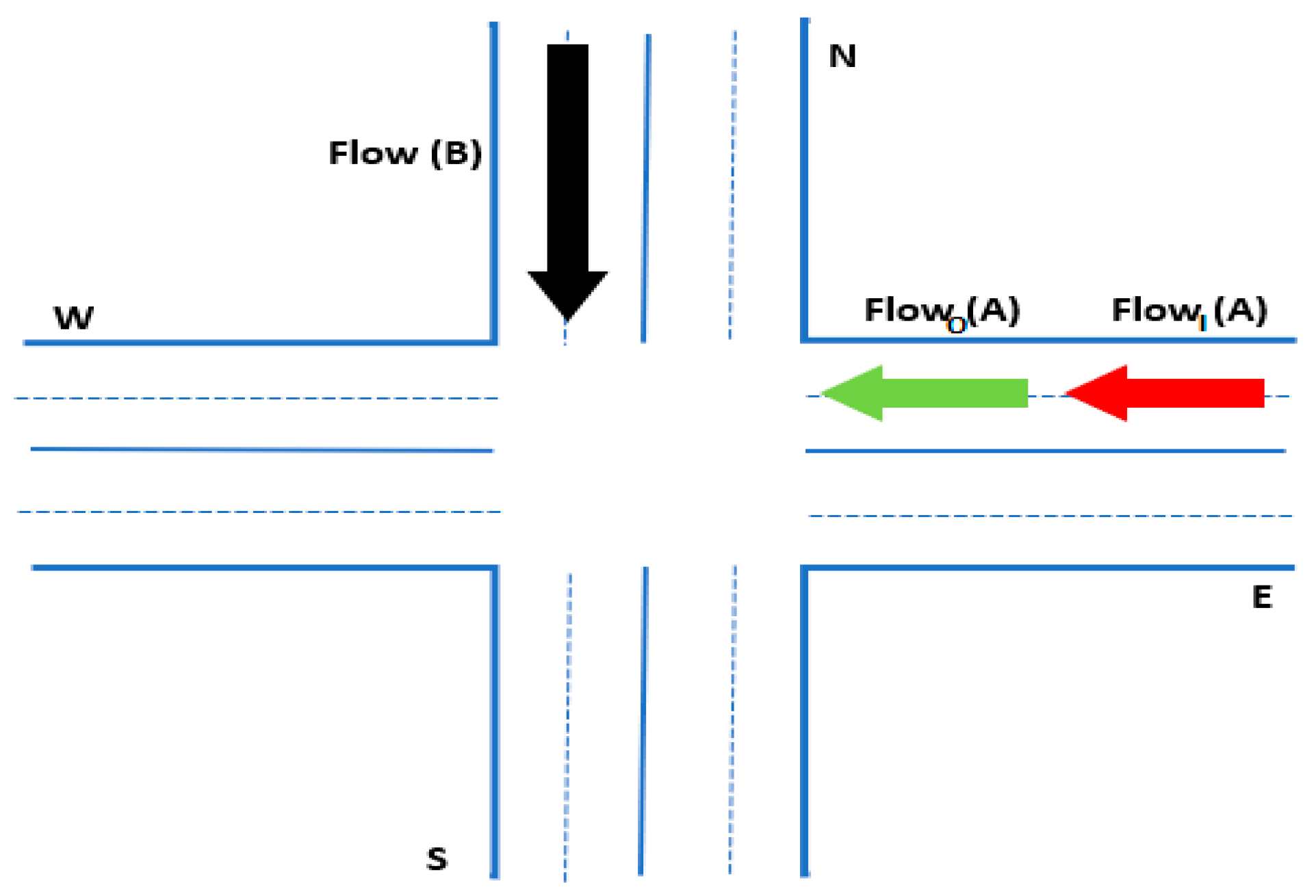
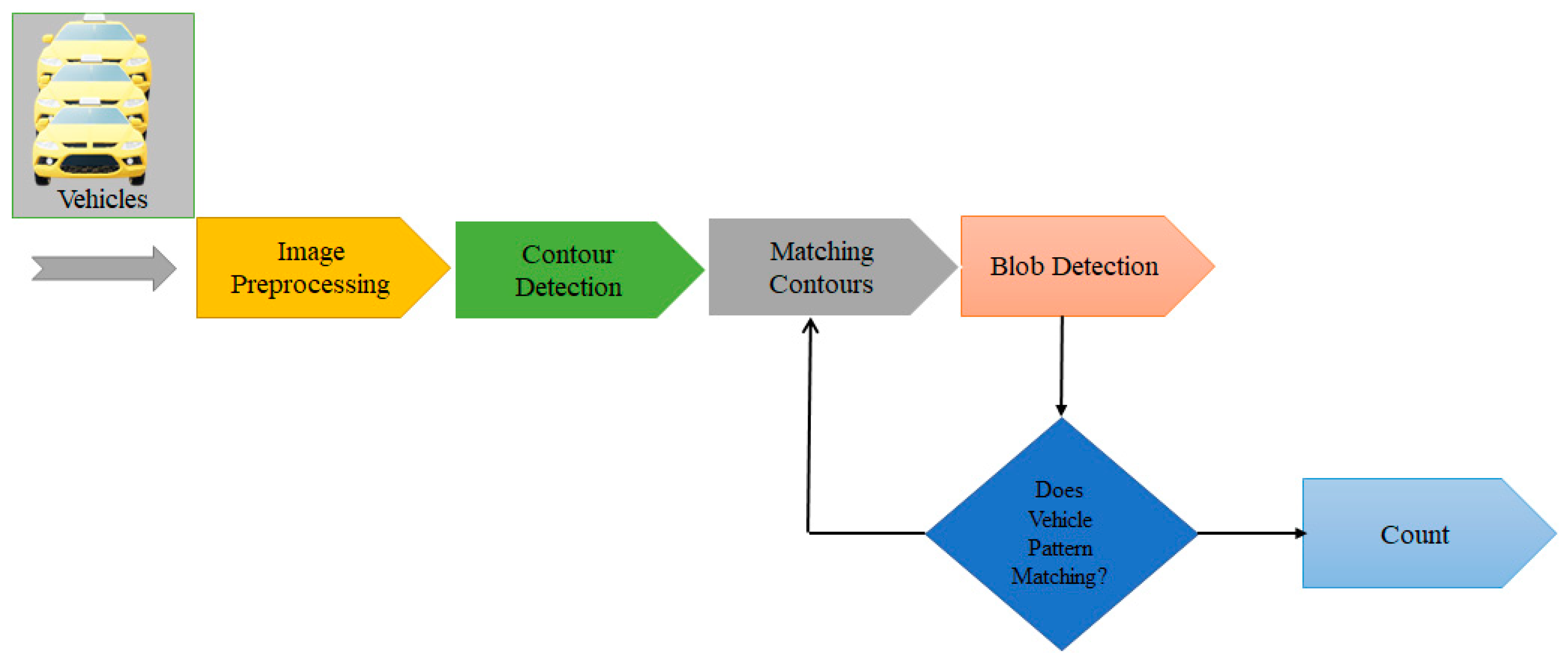




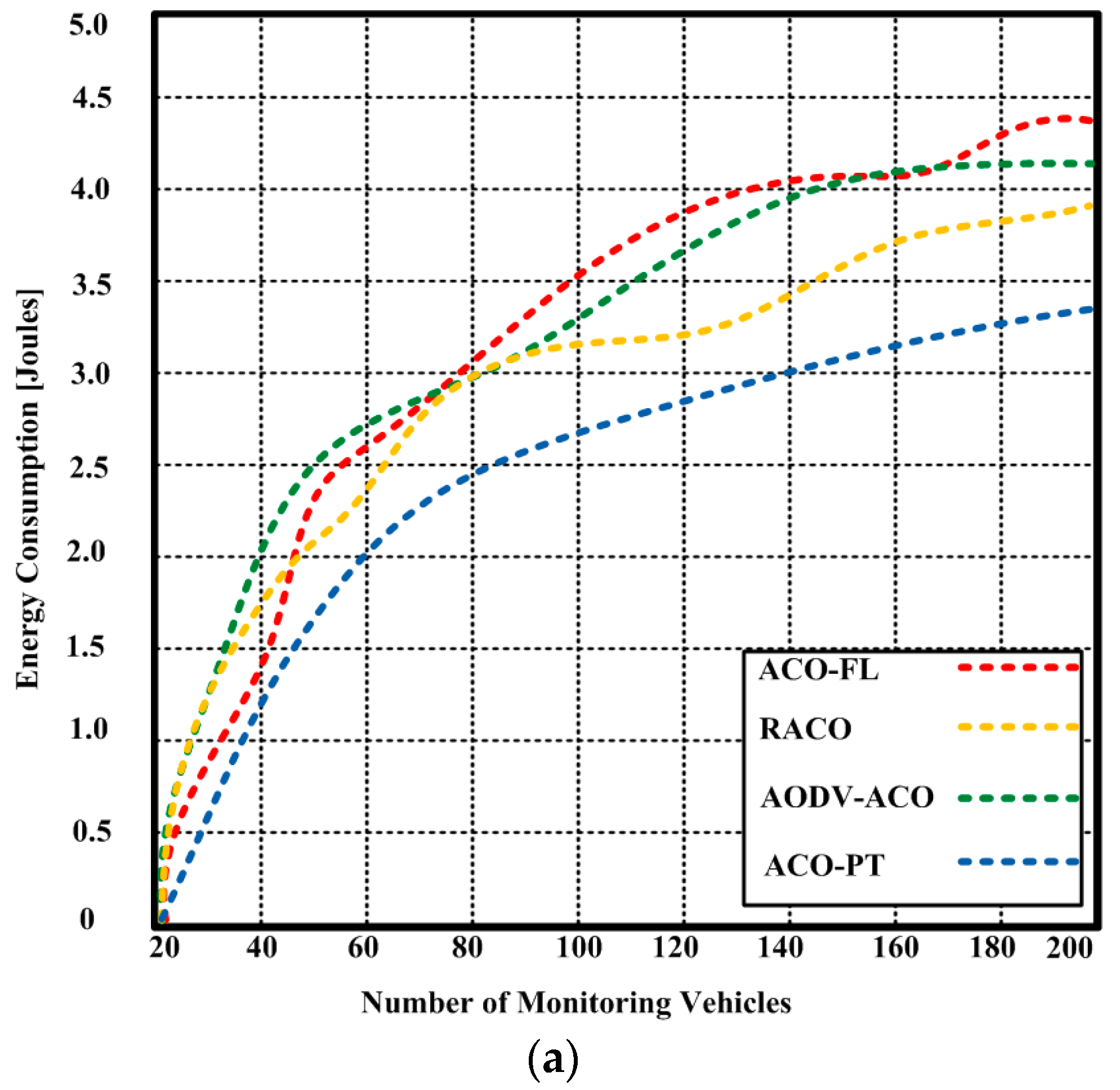
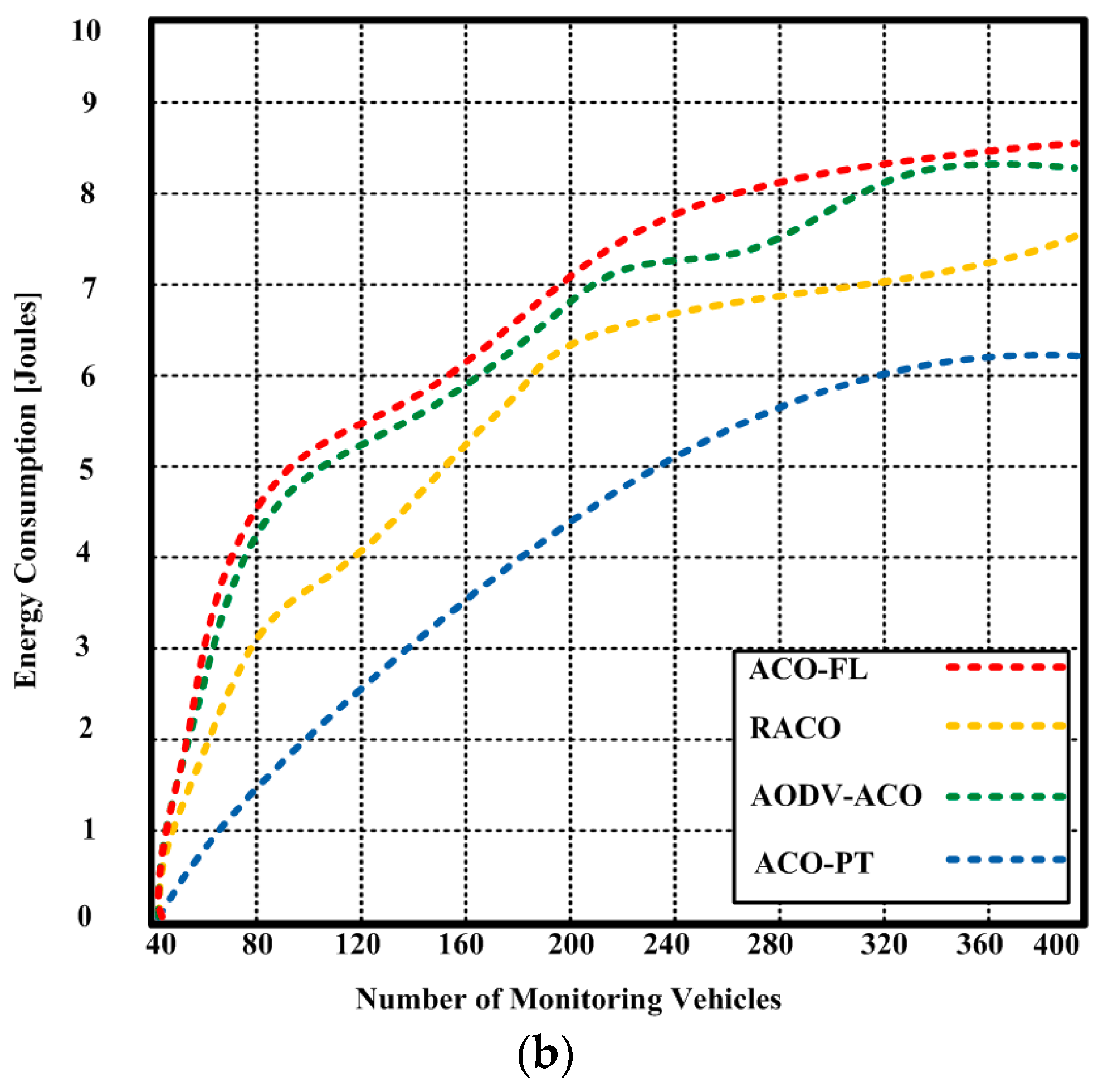
| Works | Heterogeneous Algorithm for Efficient Routing | Features and Strengths | Deficiencies and Vulnerabilities |
|---|---|---|---|
| Zhang et al. [19] | Heterogeneous multidepot cooperative vehicle-routing problem. | Improves vehicle routing by properly selecting transfer points for product transshipment between vehicles of different depots. | Increases cost savings among depots because the grand coalition is not stable in an urban environment. |
| Khabiri et al. [20] | Energy-aware clustering-based routing in wireless-sensor networks using the cuckoo-optimization algorithm. | Enhances the network lifetime and selects optimal cluster heads through the combination of clustering methods and cuckoo optimization. | The work is restricted to WSNs with stationary sensor nodes. In addition, it increases latency and delay. |
| Fatemidokht et al. [21] | An improved foundation for the ACO protocol based on fuzzy logic for VANETs. | Testing the effectiveness and performance on NS-2, this algorithm outperforms many algorithms with a higher data-packet delivery ratio and a lower end-to-end delay. It also guarantees road-safety service quality and fulfills some QoS requirements. | This protocol is vulnerable to a number of security threats. |
| Anandh et al. [22] | A hierarchical routing design and architecture in which nodes in the outer level forward data to inner-level nodes. | Increases energy saving, increases network lifespan, and reduces congestion. | With the use of ACO, certain cluster-head nodes become overburdened with data forwarding. |
| Oh et al. [23] | A framework that predicts pheromone values using quantum mechanics. | Generates the shortest and most optimal path faster than multiple algorithms. | Increases computation time. |
| Sindhwani et al. [24] | AODV combined with ACO for data transmission. | Generates a path with the shortest distance, leads to improved throughput, and reduces lost and delayed packets. | Consumes large amounts of network bandwidth and increases network congestion. |
| Martinez et al. [25] | Estimates statistical variables using a one-way road-network model. | Employs a route-planning algorithm for periodically constrained search regions that generate virtual borders with a lower confidence level. | The search process is reliable but utilizes more energy consumption for optimal path detection. |
| Haitao et al. [26] | Plans an efficient path from the present to the future. | Proposes the shortest route for packet reduction, throughput increase, and latency reduction. | Addresses only congestion. |
| Zambrano et al. [27] | Time-dependent vehicle-routing problem with time windows for congestion avoidance. | The proposed method is used for time-dependent vehicle speeds, travel times, vehicle capacities, customer demand, wait times, time windows, servicing times, the effects of dynamic loads, and the impact of travel speeds on vehicle carbon emissions. | The time window is limited to the predicted time. Therefore, the prediction cannot be accurate in most cases. |
| Yaqoob et al. [28] | Fog-assisted congestion-avoidance method for IoV. | The proposed EEMD makes use of the benefits of fog computing to save communication costs and manage services. The status of each vehicle is frequently updated to a fog server, either directly or via intermediary nodes. | Limited to communication-cost savings but not congestion avoidance. |
| Liu et al. [29] | An enhanced RES-YOLO detection technique for automated vehicle detection. | Proposing enhanced RES-YOLO for automated vehicle detection employing the capacity to decompose and providing high resilience for non-detection-category data. | No proper proof to demonstrate the automatic-vehicle-detection process. |
| Our Proposed Method | A novel heterogeneous algorithm called ant-colony optimization with pheromone termite. | The ACO-PT algorithm seeks to provide the shortest effective path from a source point to a destination point to help drivers avoid congested roads in urban areas. | Requires the computational complexity to be determined. |
| Name of Parameter | Description |
|---|---|
| Simulator | NS-3.37 simulator |
| Maximum number of vehicles | 400 |
| Transmission range | 45 m |
| Initial energy of the sensor node attached to vehicle | 5 Joules |
| Bandwidth of sensor node | 100 Kb/s |
| Size of simulated network | 900 × 900 square meters |
| Pause time | 20 s |
| Simulation time | 10 min |
| Data-packet size | 512 bytes |
| Data frame | 256 bytes |
| Power consumption | 18 mW |
| Power intensity | −18–15 dBm |
| MAC protocol | BN-MAC |
| Tested algorithm | ACO-PT |
| Competing algorithms | ACO-FL, RACO and AODV-ACO |
| Mobility model | Manhattan mobility model |
| Mobility | 0–10 m/s |
| Algorithm | Average Throughput (Kbps) | End-to-End Delay (Milliseconds) | Energy Consumption (Joules) |
|---|---|---|---|
| ACO-FL | An improved foundation for the ACO protocol based on fuzzy logic. | 68.5 | 363.3 |
| RACO | Routing using ant-colony optimization (RACO). | 65.2 | 262.3 |
| AODV-ACO | AODV combined with ACO (AODV-ACO) for data transmission. | 62.1 | 303.3 |
| ACO-PT | A novel heterogeneous algorithm called ant-colony optimization with pheromone termite. | 90.2 | 226.3 |
| Algorithm | Average Throughput (Kbps) | End-to-End Delay (Milliseconds) | Energy Consumption (Joules) |
|---|---|---|---|
| ACO-FL | An improved foundation for the ACO protocol based on fuzzy logic. | 62.1 | 388.7 |
| RACO | Routing using ant-colony optimization (RACO). | 56 | 330.8 |
| AODV-ACO | AODV combined with ACO (AODV-ACO) for data transmission. | 50 | 300.8 |
| ACO-PT | A novel heterogeneous algorithm called ant-colony optimization with pheromone termite. | 78.2 | 250 |
Disclaimer/Publisher’s Note: The statements, opinions and data contained in all publications are solely those of the individual author(s) and contributor(s) and not of MDPI and/or the editor(s). MDPI and/or the editor(s) disclaim responsibility for any injury to people or property resulting from any ideas, methods, instructions or products referred to in the content. |
© 2023 by the authors. Licensee MDPI, Basel, Switzerland. This article is an open access article distributed under the terms and conditions of the Creative Commons Attribution (CC BY) license (https://creativecommons.org/licenses/by/4.0/).
Share and Cite
Noussaiba, M.; Razaque, A.; Rahal, R. Heterogeneous Algorithm for Efficient-Path Detection and Congestion Avoidance for a Vehicular-Management System. Sensors 2023, 23, 5471. https://doi.org/10.3390/s23125471
Noussaiba M, Razaque A, Rahal R. Heterogeneous Algorithm for Efficient-Path Detection and Congestion Avoidance for a Vehicular-Management System. Sensors. 2023; 23(12):5471. https://doi.org/10.3390/s23125471
Chicago/Turabian StyleNoussaiba, Melaouene, Abdul Razaque, and Romadi Rahal. 2023. "Heterogeneous Algorithm for Efficient-Path Detection and Congestion Avoidance for a Vehicular-Management System" Sensors 23, no. 12: 5471. https://doi.org/10.3390/s23125471
APA StyleNoussaiba, M., Razaque, A., & Rahal, R. (2023). Heterogeneous Algorithm for Efficient-Path Detection and Congestion Avoidance for a Vehicular-Management System. Sensors, 23(12), 5471. https://doi.org/10.3390/s23125471






